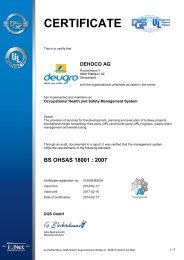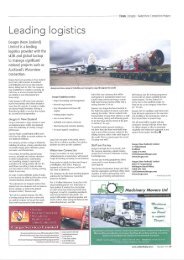CASES
You also want an ePaper? Increase the reach of your titles
YUMPU automatically turns print PDFs into web optimized ePapers that Google loves.
PNG LNG PROJECT<br />
cargosuper market<br />
‘For us, it was not just a commercial project but the chance to test ourselves again’<br />
ExxonMobil contracted Volga-Dnepr<br />
Airlines, the world’s largest transporter<br />
of outsize and heavyweight air cargo,<br />
which over more than 20 years had<br />
demonstrated its unique ability to ‘make<br />
the impossible possible’.<br />
When teams of specialists from<br />
ExxonMobil and Volga-Dnepr first<br />
got together in 2008 to discuss the<br />
project, one question dominated the<br />
conversation: was it theoretically possible<br />
to fly thousands of tonnes of large, heavy,<br />
complex and sensitive equipment into<br />
the remote Highlands of Papua New<br />
Guinea to enable the building of a gas<br />
conditioning plant?<br />
The combined expertise and knowledge<br />
of the two organisations established that<br />
undertaking such a complex air logistics<br />
task was indeed possible – but first they<br />
had to build an airport.<br />
For Volga-Dnepr, working on projects<br />
some years in advance of performing<br />
an actual flight operation is part and<br />
parcel of its unique place in the world<br />
of aviation. The size and design of big<br />
pieces of high value industrial equipment,<br />
aircraft components and space satellites<br />
are often based on their ability to fit<br />
into the airline’s fleet of giant Antonov<br />
An-124 freighters because major global<br />
corporations recognise the vital role<br />
Volga-Dnepr plays in their supply chain.<br />
In the first phase of their cooperation, a<br />
joint team from ExxonMobil and Volga-<br />
Dnepr travelled to Papua New Guinea<br />
to evaluate four proposed locations<br />
for a new Highlands airport. This was<br />
subsequently reduced to two sites<br />
following inspections and, ultimately, one<br />
location in Komo based on Volga-Dnepr’s<br />
study of load lists and route options.<br />
Back in the UK, members of ExxonMobil’s<br />
PNG LNG Project team met with the<br />
airline to plan how many An-124 flights<br />
would be required, which routes would<br />
be used, the frequency of operations,<br />
the length of the project and flight<br />
programme, and the costs involved.<br />
In 2010, work began on the new<br />
Komo Airfield.<br />
To be able to handle An-124 freighter<br />
operations would require building Papua<br />
New Guinea’s longest paved runway at<br />
3,200m in length and 45m wide. Once<br />
complete the new airport would be able<br />
continued on page 12






